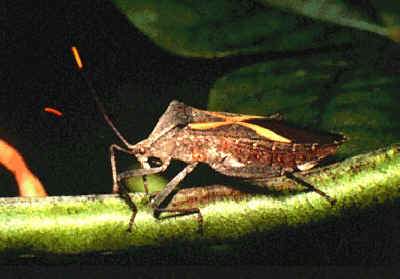
Order
HEMIPTERA(Greek, hemi = half; pteron = wing)
Common Names
bugs, leafhoppers, cicadas, aphids, scale insects.
Description
Bug mouthparts are designed for piercing and sucking. A "simple" tube (rostrum) is formed by a modification of the insect�s lower lip (labium). Inside the tube, modified mandibles form canals which allow an upward flow of liquid food and a downward flow of saliva. The modified mandibles are called stylets. Often the rostrum is held under the head but is brought forward during feeding. Compound eyes are usually present and well developed; simple eyes (ocelli) may be present. Antennae may be short with only a few segments or well developed and filiform. Most species possess two pairs of wings, but some have only one pair and a few species have none. The order name Hemiptera describes a character of the many bugs in which the front pair of wings is modified so that the basal half of each wing is hardened (sclerotised) to form a protective cover (a hemelytra). As the wings of bugs are folded flat on the abdomen, this makes the insect appear as if half of each of the forewings is missing. In the remainder of the order, the wings are held over the abdomen rather like the two sides of a house roof (e.g.cicadas).
Life Cycle
Bugs emerge from eggs as wingless miniatures of the adults (nymphs) and mature by successive moults. Some members are viviparous (give birth to live young e.g. aphids), while others have extended nymphal lives of up to 17 years (some species of cicada).
Food
Bugs feed on liquids obtained from plants (sap) or animals including humans (blood). The plant feeding bugs are considered serious pests. Large amounts of damage can be done to stone fruit, citrus and vegetable crops by such insects as the green vegetable bug, the Rutherglen bug and the harlequin bug. Scale infestations can seriously damage citrus crops while aphid attacks can harm roses. The underground aphid Phylloxera vitifoliae very nearly destroyed the French wine industry and seriously affected the Australian industry until resistant root-stocks were discovered. In Australia, lerp-insects can defoliate large tracts of eucalypt forest. Some common names include bugs, water striders, water scorpions, water bugs, water boatmen, cicadas, leaf hoppers, spittlebugs, aphids, psyllids or lerp-insects, scale insects and whiteflies.

